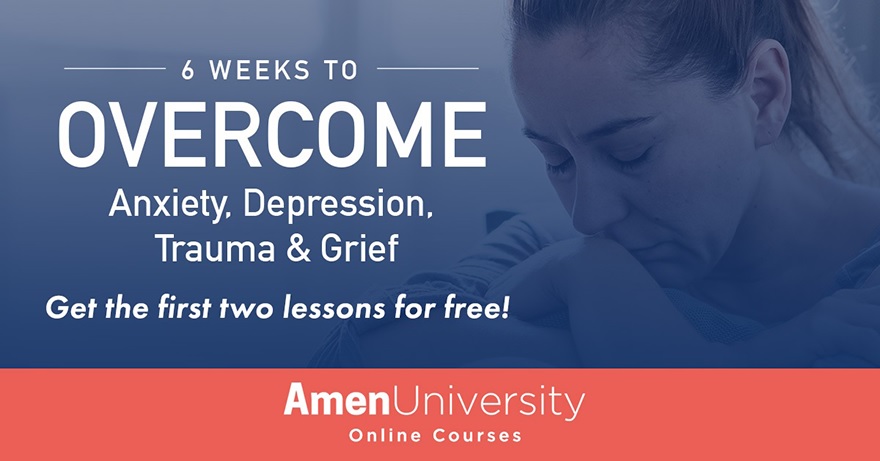
Many people live with simmering anxiety, low mood, old trauma, or heavy grief and never really get a roadmap. They collect scattered tips from books, social media, and friends, then blame themselves when nothing seems to stick. Dr Daniel Amen’s online course, Overcome Anxiety, Depression, Trauma, and Grief, aims to turn that scattered library into a more organized training that you can use step by step.
The program brings together teaching on brain health, practical psychology, and day to day coping skills. The focus is not on quick fixes. Instead, it offers a set of tools that you can practice at your own pace so you can understand what your brain is doing, calm your body, and build routines that support healing over time.
Contents
What This Emotional Health Training Aims To Do
The course is designed for people who are struggling with emotional pain themselves, as well as for family members, helpers, and professionals who want a brain based framework for what their loved ones and clients are going through. It does not try to replace therapy or medical care. Rather, it gives you language and tools that can fit alongside those supports.
A Brain First View Of Emotional Pain
One of Dr Amen’s core ideas is that emotional struggles like anxiety and depression are not only about character or willpower. They are also about how the brain is functioning. When parts of the brain are overactive or underactive, thoughts and feelings tend to follow certain patterns. The course keeps returning to this point so that shame gives way to curiosity.
From that perspective, panic, numbness, irritability, or hopelessness are not moral failures. They are signals that your brain and body are under some kind of strain. This shift does not solve the pain by itself, but it can open the door to more compassionate and effective action.
Education, Not A Replacement For Care
The training is educational, not a diagnosis or a prescription. Throughout the material there is a consistent message that intense symptoms, thoughts of self harm, or major disruption in daily functioning are reasons to seek direct help from a qualified professional. The course is best used as a structured toolkit alongside, not instead of, personal medical or psychological care.
How The Course Is Structured
The program is organized into a series of video lessons that walk through anxiety, depression, trauma, and grief in a systematic way. Each lesson focuses on a specific theme and usually ends with practical suggestions you can apply the same day.
Short Lessons You Can Revisit
Instead of long lectures, the course relies on shorter segments that are easier to absorb. You can watch them in order as a full curriculum or return to specific topics when you need a refresher, such as grounding skills during a spike of anxiety or thought strategies during a depressive dip.
This format suits people who have limited focus or energy, which is very common when you are dealing with emotional pain. You do not need to push through hours of content in one sitting. The idea is to build skills gradually.
Worksheets And Practical Exercises
Alongside the videos, the course includes written materials such as worksheets, checklists, and reflection questions. These are meant to turn nice sounding ideas into concrete steps. For example, you might write out your most common automatic negative thoughts, track your sleep, or plan specific small actions for the week.
By writing things down, you create a record of what you are trying and how it is working, which makes it easier to see patterns and progress over time.
Core Tools The Program Teaches
The heart of the training lies in the tools it offers for managing anxiety, depression, trauma, and grief. These tools are presented as skills that anyone can practice, not as instant cures.
Naming And Challenging Automatic Negative Thoughts
One of Dr Amen’s best known concepts is ANTs, automatic negative thoughts. These are quick, often harsh stories your mind tells you, such as, I always fail, nobody really cares about me, or nothing will ever change. Left unchecked, ANTs worsen anxiety and depression.
The course teaches you to slow down and identify these thoughts, write them out, and then question them. Is this absolutely true. What evidence supports or challenges it. Is there a more balanced way to describe what is happening. Over time, this practice can soften the grip of catastrophic or hopeless thinking.
Calming The Anxious Brain And Body
For anxiety, the program explains how overactive brain circuits and stress systems drive racing thoughts, physical tension, and avoidance. It then introduces grounding and calming techniques such as breathing exercises, sensory focus, and small exposures to feared situations.
The emphasis is on repeatable habits. You are encouraged to build a personal calm kit, which might include specific breathing patterns, simple movements, brief scripts you can say to yourself, and changes to your environment that make it easier to settle.
Addressing Depressive Patterns Compassionately
When covering depression, the course looks at both brain patterns and life context. It talks about how low activity in certain brain areas can create fatigue, lack of motivation, and a narrow focus on negative details. It also recognizes the impact of losses, chronic stress, and unresolved conflicts.
Tools for depression include scheduling small, meaningful activities even when motivation is low, using thoughts work to challenge hopeless predictions, and building routines around sleep, movement, and nutrition that gently support the brain. The tone is realistic. It acknowledges that some days the goal is simply to do one thing slightly better than yesterday.
Working With Trauma Memories Safely
For trauma, the course explains what happens in the brain when you live through frightening or overwhelming events. It uses simple language to describe why certain sounds, smells, or places can trigger intense reactions long after the danger has passed.
The training emphasizes safety and stability. It suggests grounding strategies, ways to recognize triggers, and guidelines for seeking trauma informed therapy such as EMDR or other approaches. The message is that you do not have to face everything alone or all at once, and that pacing is a form of strength, not weakness.
Walking Through Grief Without Rushing It
Grief gets its own attention in the course. Rather than treating grief as a problem to fix, the program describes it as a natural process that can still benefit from support. You learn about common grief reactions, why they can come in waves, and how to distinguish between healthy mourning and complicated grief that may need more intensive help.
Practical tools include ways to remember and honor what was lost, simple rituals, and ideas for staying connected with others when you feel tempted to withdraw completely. The message is that there is no exact timeline, but there are choices that can make the path less isolating.
Lifestyle And Brain Health As Emotional Tools
Throughout the course, there is a steady focus on lifestyle as part of emotional healing. This does not mean blaming people for struggling. It means recognizing that sleep, movement, food, substances, and digital habits all shape how the brain functions and, in turn, how feelings flow.
Sleep, Movement, And Nutrition
The program encourages you to experiment with small changes in these areas, such as protecting a consistent sleep window, adding gentle movement most days, and adjusting meals so that blood sugar swings are less severe. You are invited to notice how these changes affect your mood and anxiety over time.
Even when life is complicated, small lifestyle shifts can make other strategies more effective. A tired, undernourished brain has a harder time using any coping skill.
Reducing Brain Stressors
The course also highlights the role of brain stressors, such as excessive alcohol, drug use, constant digital stimulation, and chaotic environments. Part of the work involves identifying which of these are present in your life or your loved one’s life and making realistic plans to reduce them.
The approach is practical rather than moralistic. It asks what will make it easier for your brain to do the repair work it is capable of doing.
Who This Program Tends To Help Most
The training is particularly suited to people who:
- Want a structured introduction to brain based emotional health concepts.
- Prefer practical steps and worksheets rather than only theory.
- Are already in therapy or medical care and want extra tools to use between sessions.
- Support a loved one who is struggling and want to understand what they are facing.
It may be less useful for individuals in acute crisis who need immediate, intensive help, such as inpatient care or direct one to one support. In those situations, safety and stabilization come first, and self paced material can wait.
How To Get The Most Out Of The Course If You Enroll
Like any educational program, the value you get from this training depends on how you use it. Watching every video in one weekend and then forgetting about it will not do much. A steadier, more realistic approach tends to work better.
- Set a gentle pace. Choose one or two lessons per week and give yourself time to practice the tools before moving on.
- Use a notebook. Write down key ideas, your own reactions, and what you want to try. This gives you a record you can bring to therapy or medical appointments.
- Share relevant parts with trusted people. Let family members or close friends know what you are working on so they can support you.
- Combine it with professional care. Ask your therapist or doctor how the course tools can fit with your treatment plan.
- Be honest about red flag symptoms. If you experience thoughts of harming yourself or others, severe hopelessness, or major functional decline, treat that as a signal to seek direct help rather than trying to handle it alone with online material.
Used in this kind of deliberate way, Dr Amen’s emotional health training can become more than a collection of ideas. It can serve as a structured companion on the road through anxiety, depression, trauma, and grief, helping you build skills and habits that support both your brain and your daily life.

